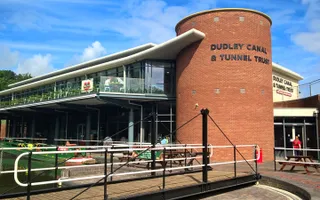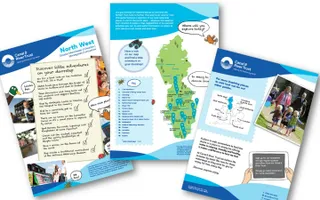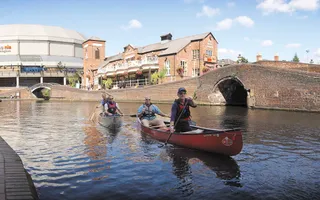The Dudley Canal was built to serve the industrial area to the west of Dudley, and later to connect the canal system to the east of the town.
Engines are not allowed in this very low tunnel – boats are legged through by manpower alone. The tunnel passes through a dramatic complex of limestone caverns, which you can explore on a boat trip with the Dudley Canal Trust. The parallel Netherton Tunnel provides an alternative route for boaters who don't fancy attempting to leg through.
The Dudley No. 1 Canal joins the Stourbridge Canal at Delph Flight. Raised water overflow points on the locks create spectacular waterfalls when the canal is high in water. This flight is known as Delph Nine Locks, although there are actually only eight, since it was rebuilt in 1858. If you look carefully, you can still spot the overgrown remains of the old flight.
Days out in Dudley
The history
The Dudley Canal's original Act was passed in 1776, on the same day as that of the Stourbridge Canal, and it opened from the junction to Ox Leasowes in 1779.
Back in 1775, Lord Dudley had started a cut from the Birmingham Canal at Tipton into his coal and limestone mines. An Act of 1785 allowed Dudley Canal to take this over and extend it through a tunnel 3,154 yards (2,882m) long to join its line, but it was not open until 1793.
The next development was for a canal, commonly known as the ‘Dudley No 2 Canal' from the original canal near Netherton, via Halesowen, through Lappal Tunnel (3,794 yards) to the Worcester & Birmingham Canal at Selly Oak. As well as serving various industries, this was an attempt to break the Birmingham Canal's monopoly.
Minor improvements were made to the line over the years, but it was not until the 1850s that dramatic changes were made. The Dudley Canal had merged with the Birmingham Canal in 1846, and both had then been leased to the London & North Western Railway. So it was under railway ownership that the Dudley Canal was transformed: the Delph Nine Locks were rebuilt as eight, the Two Lock Line shortened the route by cutting off the former circuitous route by Parkhead Junction, further cut-offs were made at Netherton, and, most significant of all, Netherton Tunnel was built. This is 3,027 yards long, has the largest bore of any British canal tunnel, and was originally lit by gas.
Because of the extensive coal mining in the area, the Dudley Canal has always suffered from subsidence. This caused the Two Locks line to close in 1909 and the Lappal Tunnel in 1917.
By the 1950s the line declined to little more than a water abstraction facility for the Round Oak Steel Works. Ironically it is the canal that has since flourished whilst the steelworks and adjacent Merry Hill Farm are no more, the gargantuan Merry Hill Shopping Centre having taken their place.









